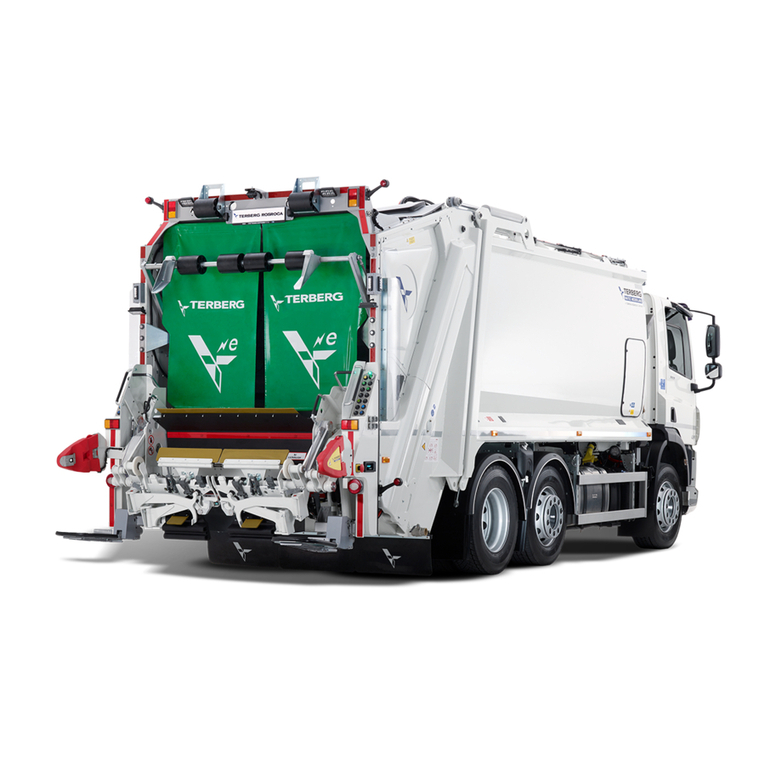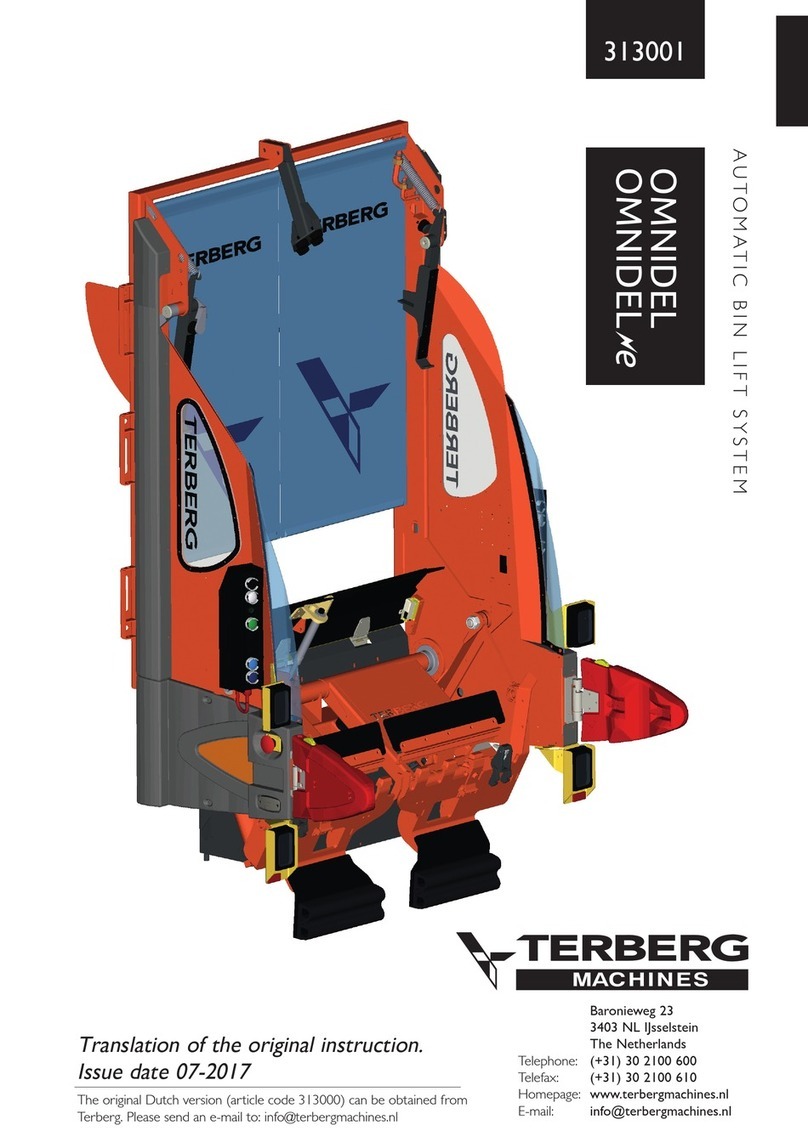
N 7
EN
37751
12-2014
2. Safety
2.2
Safety instructions applicable during operation, maintenance and repair
ãTerberg Machines B.V., IJsselstein, The Netherlands
All rights reserved. No part of this book may be reproduced, stored in database or retrieval system, or published, in any form or in any
way, electronically, mechanically, by print, photoprint, microfilm or any other means without prior written permission from the publisher.
During the operation of the bin lift system
•nsure that no-one is in the immediate vicinity of
the bin lift system during the loading cycle.
•If the bin lift system is in operation, you may under
no circumstances reach into the lifting system
(danger of injury).
•In case of danger immediately press the closest
emergency stop switch
(see section Safety equipment 2.4).
•Check that there are no foreign objects in or
between the bin lift system that can hinder its
operation.
•Loose refuse may not be loaded above the edge
of the hopper.
•The compactor may not be used while objects are
protruding from the throw-in hole.
•Never use the bin lift system when the view of the
load is obstructed.
•Never use the bin lift system on a very uneven
surface.
•The bin lift system may not be driven up against a
bin/container or a pile of refuse.
•Take account of the heating of the hydraulic oil.
This can become 40°C warmer than the environ-
ment. As a result, the pipes and hoses can cause
light burns at high ambient temperatures.
•It is not permitted to use bin/container types not
listed in the manual.
•Nothing should protrude from the bin and only
bins whose lids are fully closed should be emptied.
•Do not empty any damaged bins. These can cause
problems.
•Overweight bins/containers should be removed
from the bin lift system:
max. lifting force 2-wheel bins: 1600N (160kg)
max. lifting force 4-wiel containers: 7500N (750kg)
•Check that the container is located correctly on
the pick-up comb or pick-up arms before you
empty it.
•Let go of the bin as soon as it is picked up by the
bin lift system.
•It is expressly forbidden to manually ‘help’ the lift-
ing system.
•Only give an extra shake if this is needed.
•Only remove the bin/container when the bin lift
system has come to rest and the bin/container is
back on the ground.
•Place empty bins/containers where they do not
pose a danger to other road users.
•It is forbidden to empty bins/containers that con-
tain dangerous and/or radioactive substances.
•It is not permitted to empty bins/containers that
contain burning or smouldering materials.
•Never walk backwards towards the bin lift system.
•One person offering and/or taking several bins at
the same time must be kept to a minimum.
•A bin may only be offered to the bin lift system
when held by the handle bars.
•During winter conditions, if the bin lift is contami-
nated by heavy snow or ice deposition on mecha-
nical parts or various sensors, the system can get
clogged up. Apply stop switch prior to cleaning.
Clean these parts and keep as dry as possible. For
example with a broom. Never clean the bin lift
using defrosting liquids!
During maintenance and repair
•Maintenance and repairs may only be carried out
by authorised technical personnel.
•Any faults detected should be corrected before
the bin lift system is used.
•For maintenance and repairs switch the bin lift sys-
tem off (switch off the engine of the refuse col-
lection vehicle and turn off the main power
switch).
•During repair work, accidental activation should
be prevented by removing the ignition key from
the ignition switch (keep on your person).
•You may not go under the tilt frame for repair or
cleaning unless the tilt frame is adequately sup-
ported.
•Before cleaning can begin, you should switch off
the drive gear of the refuse collection vehicle.
•The grease between the pivots may get washed
away if you use a high pressure cleaner. Think about
the safety of your eyes and use safety glasses.
•Use the lifting points present for raising the bin lift.
•When working on the hydraulic system, you should
bear in mind that this is filled with hydraulic fluid
under pressure. Always use personal protective
equipment to avoid contact with skin and eyes. Use
absorbents to avoid environmental pollution.
Keep a minimum distance of 2.5 meter
between the bin lift and objects which are
located behind the bin lift system. his is to
avoid a dangerous situation in case that a bin
comes loose.





























